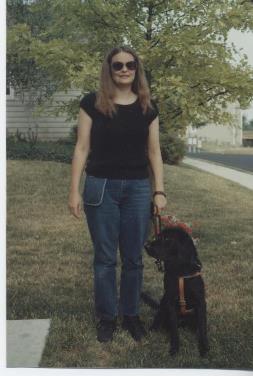Nearly half of all guide dog teams say they’ve been attacked
by Beth
Donna Smith is the Director of Training with Easter Seals Project Action, and both of us are Seeing Eye graduates. Here she is with a guest post.
Protecting service animals at work
by Donna Smith
Service dogs are deservedly admired and often loved for the work they are trained to do to assist people with disabilities in performing daily tasks. Stories about service dogs appear regularly on animal TV shows, in newspaper articles, and in elementary school curricula (I love hearing stories of children going home to proudly teach their parents how they should never pet or distract a “working dog”—what a wonderful way to raise the awareness of appropriate behavior when encountering a person using a service dog).
One area that fails to get enough attention when it comes to using a service dog, however, is the damage that can be caused by other animals who are not properly controlled by their owners. Seeing Eye, Inc. surveyed guide dog users in 2011, and 44% of the guide dog users who responded said their working dog had been attacked by other dogs, and 83% said they’d experienced aggressive interference by other dogs.
While none of my service dogs have ever been attacked by another animal, I know firsthand what the threat of an attack feels like. I lived in Mississippi with my first Seeing Eye dog. Zane and I left for work so early in the morning back then that most of our walks to the bus were very peaceful. We rarely encountered another person, dog or car. Occasionally, though, a pair of chows would get out of their fenced yard and circle around us.
I could hear these dogs coming, and then feel them panting at my ankles as they circled around us. One or the other would come in close, rush at my dog, back off, then circle again. This didn’t happen every day, but the mere threat of it happening turned what should have been a peaceful three-block walk to the bus into a very isolating and high-stress experience.
Zane was a large, Black Lab, a very steady worker who was protective of me. My job was to keep us moving, making it far less likely for the dogs to engage in a staring match (the typical precursor to actual fighting). I was always very worried. I knew my dog would try to protect me, but he was outnumbered, and I wondered if his harness might prevent him from avoiding injury.
The owner of the chows refused to discuss the situation with me. Leash laws existed, but animal control said they could not act until an attack occurred. Advocates eventually got a state law passed that made such harassment punishable by imprisonment and/or a fine, but that was long after I moved out of state.
The Seeing Eye continues to work to get such laws passed state by state, and earlier this month I was pleased to hear that New Jersey joined a growing list of states with laws like this by passing “Dusty’s Law” to protect service animals and guide dogs in training. Check out the Seeing Eye web site for a list of states and their existing service animal legislation. There’s tips and information for the general public and law enforcement there, too.








March 4th, 2014 at 5:06 pm
I had never really thought about the possibility about an attack/taunting by “civilian” dog, but this article made me think a little about what could possibly be done in order to protect both parties. I agree that the owners should be ticketed each time the incident happen and that bringing this issue to light a letter should be written to the township. I know that nothing can ever be 100%, but I think the first step would be public awareness, via more education about leash law that is requires for all dog owners. In this particular case the owner (of the Chow dog) needs to be held responsible for the actions their dog has done.
February 3rd, 2014 at 8:07 pm
The “chow” incident is an unfortunate lack of enforcement of the law. If there is a leash law, as most communities have them, then an owner should have been ticketed each and every time for dogs off-leash and out of their yards. Chows are known for being dog aggressive; if a child passed by, the incident could have been even more disturbing. Perhaps a letter to the city council or the newspaper would have encouraged enforcement of this law.
I trained a dog for over six years to be more comfortable on the leash and meet new dogs; it is a challenge when dogs see extra harnesses and can put them on the defensive. But, always, always, it should be the responsibility of the NON-guide dog owner to keep their distance and allow the other dog to do their work without causing their owner any sudden mishaps. Guide dogs may lunge first to protect themselves or their owners if they sense any challenges coming from the new dog. They are chosen because they are good at taking their job seriously, and I would never presume that they are trigger happy to “rumble” with another dog.
February 3rd, 2014 at 6:13 am
Guide dog users should be safe, but many many times I have observed the guide dog giving the lets rumble look to the other dog. Many time when out with me late service dog he would be attacked by a guide dog when we crossed paths. The guide dog users need to also understand how to read thier dog. I always announce myself when approaching a guide dog team so the person can prepare. As a service dog user you must keep up with training